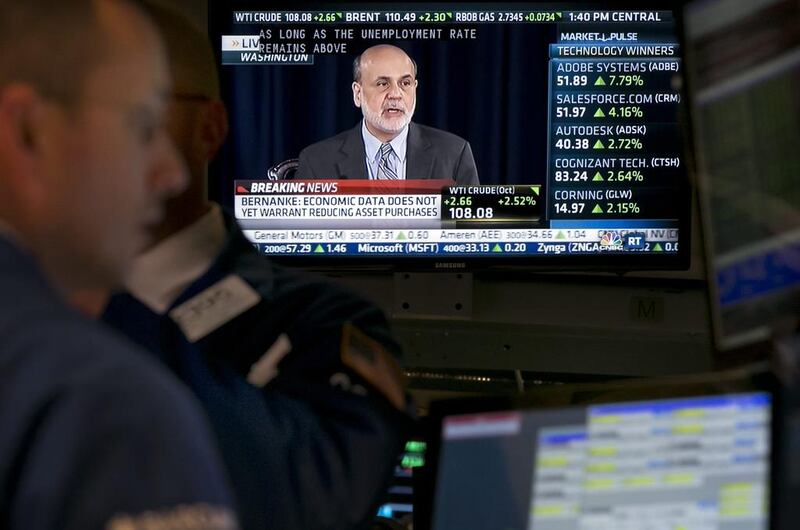The US Federal Reserve stunned markets this week by maintaining US$85 billion of quantitative easing (QE) asset purchases a month, confounding consensus estimates that monetary policy normalisation would begin this month, as a positive reflection of the recovery under way in the US economy.
The Fed’s balance sheet will thereby continue to grow, having risen from about US$1 trillion when QE began in 2009, to almost $4tn this year, with a reduction in asset purchases likely to now take place over a more drawn-out timetable, and probably not ending completely until nearer to the end of next year. An interest rate rise in the US also appears to be a prospect for further out, with an eventual unwinding of the QE already in the system not expected to occur for a number of years to come.
The message for financial markets in general and for equities in particular would seem to be a positive one in the first instance, in that the monetary stimulus taps will remain on for much longer than previously assumed. This is also an encouraging signal for emerging markets, which have suffered over the summer as fears grew that QE was about to come to an end. However, there are also significant risks that stem from delaying the exit from QE, especially given the uncertainty created by the Fed appearing to change direction.
In refusing to taper this week, the Fed was clearly fearful of a tightening of financial conditions, which if sustained could slow the pace of economic improvement. The main concerns here appear to have been the recent rise in bond yields, to almost 3.0 per cent for 10-year US treasuries, and the accompanying rise in mortgage rates since the Fed chairman, Ben Bernanke, started talking about reducing the stimulus in May. The Fed also expressed some fears over fiscal policy, a reference perhaps to the debt ceiling talks that will be taking place next month, with political wrangling in Washington having the potential to spook markets further.
The Fed maintained its zero to 0.25 per cent main policy interest rate and much of its previous forward guidance, while it expressed concern about the risk of inflation staying below 2 per cent. The Fed also left its 6.5 per cent unemployment and 2.5 per cent inflation thresholds intact, although Mr Bernanke noted that the unemployment rate may need to fall “considerably” below its 6.5 per cent threshold before the central bank starts raising interest rates. Unsurprisingly given the lack of tapering action this month, the Fed cut its near-term growth forecasts, with its projections for the target Fed funds interest rate showing only a modest rise in 2015. Growth in 2016 is expected to be stronger, but the Fed funds rate is expected to be still well below its long-term average.
Meanwhile the Fed continued to emphasise the data-dependent nature of any decision to moderate asset purchases. While the initial market reaction was unsurprisingly euphoric, with equities rallying to all-time highs, bond yields falling and the US dollar also losing ground, the Fed’s message might be seen as raising more questions than it answers.
Indeed the longer-term reaction may not be quite so straightforward. The Fed has placed a great deal of store by the need to communicate effectively with the financial markets through its relatively new policy tool known as forward guidance. Given that the Fed had appeared to set up the market to expect a reduction in stimulus this month (since Mr Bernanke’s last press conference in June, and with the economy meeting much of the criteria laid out since then), the fact that they did not will raise questions about the worth of this forward guidance, leaving markets confused about the outlook for monetary policy. In particular, Mr Bernanke’s previous assertion that QE would be more or less completed when the unemployment rate reaches 7.0 per cent was hardly mentioned this week. The next focus for Fed tapering will probably fall on the Fed’s December meeting (when another press conference is to be held), but it could even be pushed back further into next year given what Mr Bernanke said.
Furthermore, the lack of a QE taper may actually damage the US economy, by raising questions about the strength of the recovery to date and damaging consumer and business confidence in the process. The fact that the Fed downgraded its growth forecasts makes it a little curious that the equity markets took the news quite so positively. The Fed’s credibility might also suffer as a consequence which could create a more volatile performance by major markets. In particular, to the extent that equity markets received a significant boost from the Fed’s message this week, any eventual tightening could contribute to a much bigger bust later. Likewise, should growth improve and inflationary pressures begin to emerge, US treasury bonds could be punished even more heavily down the road because of the Fed’s current caution.
Undoubtedly the Fed’s inaction will be received positively by emerging markets around the world, and this region should be no exception. The GCC states have already demonstrated resilience as the developed world has stuttered, with regional growth rates firm, and its financial markets among the best performers globally this year. The postponement of monetary withdrawal in the US should keep regional optimism positive for now, as interest rates remain low for longer. But of course postponed is not the same as removed, and all the world’s markets should remain aware that the longer-term risks have probably increased, not diminished, as a result of the Fed’s inaction.
Tim Fox is the head of research and chief economist at Emirates NBD but is writing here in a personal capacity





